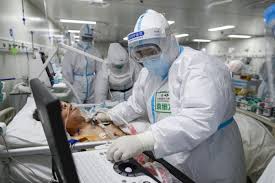How to be a Medical Doctor(Step-and Requirement)

Being a medical doctor is a wonderful and fulfilling career choice if you have ever dreamed of assisting people in maintaining their health and happiness. Even if you are still in high school, there are numerous things you can do to set yourself on the correct course.

Even while it does take a while to complete all of your training, once you do, you’ll be qualified to practice medicine. Continue reading to learn more because we know you undoubtedly have some queries about the entire procedure.
You can find working as a doctor fulfilling if you want to pursue a career in healthcare. A doctor, often known as a physician, is a medical professional who assists patients in maintaining and enhancing their health.
Finding out what a doctor does and how to become one will help you determine if this career path is a good fit for your skills and professional objectives. We go over what a doctor does, how to become one, and what their typical pay is, and we provide answers to frequently asked questions about pursuing this career in this post. How to Stay Focused (Steps and Requirements)
What does a doctor do?
A doctor is a medical professional who aids in the prevention, enhancement, and maintenance of patients’ health. They discuss potential health issues with patients, assess the state of their health, and encourage the development of good habits. Doctors also evaluate illnesses and injuries, carry out tests, and offer medical condition diagnoses and treatments.
There are many different kinds of physicians, and they frequently direct their patients to another practitioner if the patient needs specialized treatment in a particular branch of medicine. A doctor’s practice area is known as a specialization, and it enables them to specialize in particular body systems and functions while still providing patients with high-quality care. Here are some popular medical specialties:
- Family doctor: A family doctor treats children and adults who need preventive care, treatment for mild ailments, or care for injuries. They can perform tests, identify serious health issues, and refer patients to specialists.
- Internal medicine doctor: Adult patients receive primary care from an internal medicine doctor. Although they frequently work in hospitals, general practitioners can also start their own practices or join medical groups.
- Pediatrician: Children’s medical needs are taken care of by pediatricians. They give immunizations, annual examinations, and treatment for mild illnesses like the flu or a sore throat.
- Obstetrician and gynecologist (OB/GYN): An OB/GYN is an expert in sexual and reproductive health. They offer contraception, physicals, therapies for infertility, and pregnancy care, including childbirth.
- Surgeon: A surgeon performs operations on patients to inspect the patient’s internal organs, collect tissue samples for laboratory analysis, or remove harmed tissues to improve the patient’s health. Subspecialties for surgeons include heart surgery and neurosurgery.
Read Also: How to Build Healthy Bones (Top Strategies: 2023)

How many years does it take to become a doctor
It can take around 10–15 years after high school
Before you may apply to medical school, you must complete a 4-year college degree after graduating from high school. A further four years of medical school study are followed by a few years of “residency” training before you are qualified to sit for the United States Medical Licensing Examination (USMLE), which you must pass in order to practice medicine without limitations.
- Although it may seem like a long time, your experience will help you meet others in your field and deliver the greatest care.
- Do not restrict yourself to a pre-medical or hard scientific program; medical schools will accept any major provided you finish the prerequisite courses.
- You have the option of earning an allopathic (MD) or osteopathic (DO) medical degree in the US. Both degrees will let you practice medicine; the only distinction is that it is more challenging to enroll in an MD program, even though the coursework and training are the same.
How to become a medical doctor
1. Earn a bachelor’s degree
Getting your bachelor’s degree is the first requirement to become a doctor. Although applicants to medical schools are not often required to declare a major, they must typically pass certain necessary courses in order to be admitted. As part of your undergraduate degree program, you can assist yourself fulfill these criteria by earning a degree in biological science or chemistry.
Your chances of being admitted to elite colleges may increase if you perform well in math and science classes. You can also participate in extracurricular or voluntary activities to strengthen your applications to undergrad and medical school. These programs give you the opportunity to obtain real-world experience in a classroom and workplace context, which could help you thrive in medical school and in your career.
2. Pass the Medical College Admission Test (MCAT) exam
You can take the Medical College Admission Test in your third year of undergrad (MCAT). Your performance on this standardized test, which assesses your readiness for medical school, will affect whether you are accepted. Every university has a different minimum score requirement, but many do. The multiple-choice questions on the test measure your linguistic and problem-solving abilities.
In order to get a better grade on the test, you can study for it in areas like biology, chemistry, and physics. Additionally, there are MCAT books available for purchase or library checkout, online practice exams, and classes you can enroll in prior to the exam. Since you can take the MCAT up to three times year, many college students register as soon as they are qualified.
3. Enroll in medical school, then complete your education
The summer before your senior year is when you can start applying to medical schools. Typically, candidates will use the American Medical College Application Service (AMCAS). You can use the AMCAS system to apply to medical schools across the nation by searching this single database for their application deadlines.
Programs at medical schools typically last four years once you’ve enrolled. You can learn about several medical specializations by participating in the curriculum’s two sections: classroom instruction and on-site clinical work with doctors. Among the classes you take in medical school are:
-
Pathology
-
Anatomy
-
Biochemistry
-
Medicine
-
Chemistry
-
Organic chemistry
-
Statistics
-
Calculus
4. Pass the first two parts of the U.S. Medical Licensing Examination (USMLE)
The United States Medical Licensing Exam is the following prerequisite to becoming a doctor (USMLE). This test assesses your readiness for a profession in medicine, including your fundamental knowledge and comprehension of medical norms and procedures. Students take the first two parts of the USMLE during their first two years of medical school.
During your third year in the program, you can anticipate taking the first part, which tests your knowledge of medical principles. You can take the second section of the exam right after finishing your clinical rotations in your third year of medical school. This part tests your ability to apply your knowledge and skills in the field. The third section takes place at the end of medical school.
5. Choose your specialty and begin your residency program
It’s crucial to select a specialization during your third or fourth year of medical school so you can get ready to pursue a residency in that field of practice. A residency is a postgraduate training program that enables you to practice as a licensed doctor under the supervision of a skilled medical professional in your field. Depending on the field of practice, residency programs might last anywhere from three to seven years.
You can anticipate giving patients direct care as a resident. This could entail diagnosing conditions, assessing patients, conducting tests and treatments, and treating wounds and illnesses. Supervisory physicians provide feedback to residents, allowing them to recognize their strengths and learn new skills to enhance patient care.
6. Pass part three of the USMLE exam and obtain your state’s medical license
Your ability to prioritize patient care and practice medicine skillfully is tested in the third USMLE section. This course can help you get ready to work on your own in your state during your residency program. The third USMLE step is a two-day exam with case simulations and multiple-choice questions that takes 16 hours to complete.
To obtain a license, a medical doctor must pass every section of the USMLE. Other requirements for the state medical board can range, but they could include the following :
- a minimum of one year of postgraduate study
- evaluations of one’s physical and mental health
- evaluation of character fitness
Read Also: How To Stop Drinking Alcohol ( Step- by Step- Guide )
How do I pick a medical field of study?
1. Pick something you enjoyed doing in med school
You get to decide what area of medicine you wish to concentrate on during your last years of medical school. Consider carefully what you enjoyed learning about and whether those career paths are what you want to pursue. If you’re unsure of what you want to do, speak with a counselor or advisor at your school who can guide you toward the career path that best suits you.
- If you wish to work with younger patients, for instance, consider a career in family or pediatric medicine.
- For another instance, you might choose to pursue orthopedics if you demonstrated a strong interest in bones and joints in class.
- Radiology, orthopedic surgery, integrated plastic surgery, and neurological surgery are some of the medical disciplines with the highest levels of competition.https://enoughinfo.com/
2. Decide if you want to be in a hospital or private practice
In a hospital, you’ll work more collaboratively with teams and have administrators take care of all the necessary paperwork. However, working at hospitals can be more stressful because of the range of patients you interact with and the fluctuating nature of your schedule from week to week. Opt for a private clinic instead if you want more control over your schedule and stronger relationships with your patients.
- Medical specialties like general surgery or internal medicine at a hospital may be a good fit for you if you enjoyed doing rounds during medical school.
- If you want to work in a specialist clinic and want to have more control over the patients you see, think about a career in pathology, dermatology, or psychiatry.

FAQs about becoming a medical doctor
1. What is a Medical doctor’s salary?
You’ll typically make about this much a year on average if you exclusively practice basic medicine. Depending on how challenging your work is, you’ll probably make more money if you specialize in a certain area of medicine.
- As an illustration, dermatologists often make $350,000 USD a year, whereas neurosurgeons can make up to $550,000 USD.
- It relies on a variety of elements, such as your area of expertise and where you work. From $185,000 to over $500,000 is possible.
2. How challenging is medical school?
In the majority of nations, becoming a medical doctor is a protracted, demanding procedure that calls for a high level of commitment and expertise. While there are many different international educational models, the majority of them call for a study period of between five and eight years before a medical degree is awarded.
Read Also: How to Become a Pilot (Steps and Requirements)
conclusion
A medical doctor is a person with the training and credentials to provide medical care in an effort to maintain or improve physical and mental health. A doctor’s duties include dealing with patients, making medical diagnoses, and effectively treating disease or injury. Students can pursue a variety of specialized studies in the medical sector.




